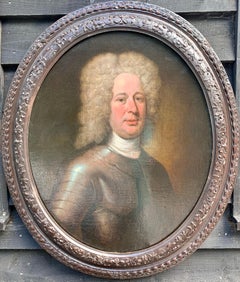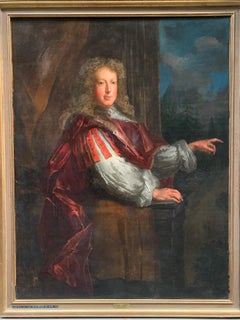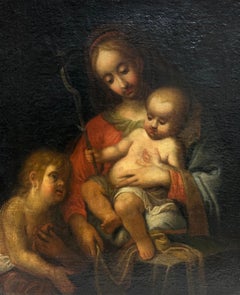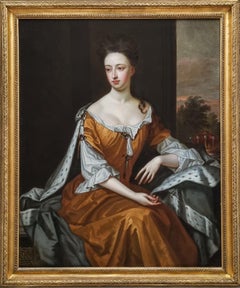Studio of Sir Godfrey Kneller Art
to
1
1
1
1
2
1
1
Overall Height
to
Overall Width
to
2
2
1
1
1
1
1
2
2
2
6,996
3,377
2,513
1,212
2
2
1
1
Artist: studio of Sir Godfrey Kneller
18th century oil painting English portrait of a gent in armor, wearing a wig
By studio of Sir Godfrey Kneller
Located in Woodbury, CT
Outstanding early 18th century English portrait of James Bellevue.
The portrait was always believed to be the work of Sir Godfrey Kneller who was known to have painted James Bellevu...
Category
Early 1700s Old Masters Studio of Sir Godfrey Kneller Art
Materials
Oil, Canvas
Portrait of Mr. Bagnal Sir Godfrey Kneller and Studio
By studio of Sir Godfrey Kneller
Located in Miami, FL
Sir Godfrey Kneller with the studio, Inscribed Mr. Bagnal Lower left. Godfrey Kneller and studio, relined, old cleaning. Old Frame. The frame was repainted and has some chipping an...
Category
1710s Old Masters Studio of Sir Godfrey Kneller Art
Materials
Oil
Related Items
John Hervey Portrait on occasion of receiving the Title 1st Earl of Bristol
By (Circle of) Godfrey Kneller
Located in Firenze, IT
Portrait of John Hervey, 1st Earl of Bristol (1665-1751).
Early 18th-century near-life-size portrait of a noble man richly dressed in a long wig.
Circle of the German-British cour...
Category
Early 18th Century Old Masters Studio of Sir Godfrey Kneller Art
Materials
Canvas, Oil
H 66.93 in W 53.15 in D 1.58 in
Fine Italian Old Master Oil Painting c. 1700's The Madonna Christ Child St. John
Located in Cirencester, Gloucestershire
The Madonna, Christ Child and St. John
Italian Old Master, circa 1700's period
oil painting on canvas, unframed
Canvas: 28.5 x 24 inches
conditon: overall very good for its age, a fe...
Category
Early 18th Century Old Masters Studio of Sir Godfrey Kneller Art
Materials
Canvas, Oil
Manner of Guido Reni (1575-1642) The Prophecy of Simeon Large Antique Painting
Located in Cirencester, Gloucestershire
Artist/ School: Manner of Guido Reni (1575-1642) Italian
Title: The Prophecy of Simeon
Medium: oil painting on canvas, unframed
Painting: 21.5 ...
Category
Mid-18th Century Old Masters Studio of Sir Godfrey Kneller Art
Materials
Oil
Fine 17th Century Old Master Portrait of Queen Henrietta Maria Exceptional Frame
Located in Cirencester, Gloucestershire
Portrait of Queen Henrietta Maria,
British/ Flemish, 17th century
Circle of Anthony van Dyck (1599-1641) Flemish.
Oil on canvas, 25.25" x 20.5" (64.1 x 52cm)
the work is presented ...
Category
Mid-17th Century Old Masters Studio of Sir Godfrey Kneller Art
Materials
Canvas, Oil
H 35.25 in W 30.5 in D 2 in
18th century Portrait of a lady as Erato, the muse of poetry - Angelica Kauffman
By Angelica Kauffmann
Located in Antwerp, BE
18th century English school portrait of a lady, said to be Mrs. John Ruscombe of Colne, Lancaster, as the muse Erato
This very skilfully painted portrait depicts a lady as the muse Erato, playing the Lyre. Her eyes are filled with emotion and her lips are curved in a soft, delightful smile. Hinting at the love song she is composing? Erato is one of the nine Muses in Greek mythology. She is the muse of lyric poetry, love poetry, and mimicry. Erato is often depicted holding a lyre, symbolizing her association with music and poetry. She inspires poets and writers to create works that celebrate love, beauty, and human emotions.
Our painting was sold in the early 1900s as a work by Angelica Kauffman. Kauffman was an 18th-century Swiss Neoclassical painter who achieved significant success and recognition in a male-dominated art world. Born in Switzerland in 1741, she showed exceptional talent from a young age and received formal art training in Italy. Kauffman gained fame for her historical and mythological paintings, as well as her portraits, which were characterized by their grace, elegance, and classical influences. She was a founding member of the Royal Academy of Arts in London and enjoyed patronage from aristocrats and royalty throughout Europe. Kauffman's work contributed to the rise of Neoclassicism and she remains one of the most prominent female artists of her time.
Measurements:
Oil on canvas ca. 98 by 77cm and with the frame ca. 118 by 97 cm
Provenance:
Collection of Felix Gouled
American Art Association, Anderson Galleries, by 1937
Kende Galleries at Gimbel Brothers, Jay Gould...
Category
18th Century Old Masters Studio of Sir Godfrey Kneller Art
Materials
Canvas, Oil
H 38.59 in W 30.32 in
Portrait of Lady Caroline Price
By George Romney
Located in Miami, FL
DESCRIPTION: Perhaps the best Romney in private hands. If Vogue Magazine existed in the late 18th century, this image of Lady Caroline Price would be ...
Category
1970s Old Masters Studio of Sir Godfrey Kneller Art
Materials
Canvas, Oil
17th century Old Master painting - Allegory of Justice - truth demons skeleton
Located in Antwerp, BE
Late 17th, early 18th century old master oil painting depicting an allegory of Lady Justice holding demons at bay
Our painting, likely a sketch for a much larger work,, conveys a pr...
Category
18th Century Old Masters Studio of Sir Godfrey Kneller Art
Materials
Canvas, Oil
H 33.86 in W 27.56 in
Antique Continental Old Master oil after Murillo, fine gilt frame
Located in Cirencester, Gloucestershire
Artist/ School: 18th/ 19th century Continental School, after Murillo
Title: Figures eating Grapes
Medium: signed oil painting on metal, framed.
Size:...
Category
19th Century Old Masters Studio of Sir Godfrey Kneller Art
Materials
Oil
19thc century classical French portrait sketch of a North African mans head
Located in Woodbury, CT
Outstanding small oil on velum sketch of a North African/ Arab head study.
The painting is a classic sketch and I'm sure the figure would have been used in a much larger finished w...
Category
1850s Old Masters Studio of Sir Godfrey Kneller Art
Materials
Oil
Free Shipping
H 12 in W 10 in
17th century Flemish Old master - Silenus feasting - Wine God
Located in Antwerp, BE
17th century old master painting "Silenus feasting", likely studio of Sir Anthony Van Dyck
Born in Antwerp in 1599, Anthony Van Dyck entered the studio of Rubens (1577 - 1640) at the age of nineteen. Quickly, the master perceives the talents of the young prodigy and makes him his first assistant. Van Dyck, for his part, has a particular admiration for the man whose name is known throughout Europe. In 1619, he was inspired by a drunken Silenus by Rubens, produced one or two years earlier for a composition on the eponymous theme. This work, now in the Dresden Museum, appears to be the first version of our painting. That work has an illustrious provenance; it was recorded in the private collection of Leopold Wilhelm (Archduke of Austria) in 1662, in 1722 it was bought by the famous German painter Antoine Pesne for the King of Saxony in Dresden (Staatliche Kunstsammlungen Dresden - Gemäldegalerie Alte Meister, Dresden, inventory number 1017). From 1945 until 1955 it was on display at the Pushkin Museum in Moskou, after having been taken by Russia after the Second World War. It was then returned to the Staatliche Kunstsammlungen Dresden where it is still on display.
Our painting is of a fine quality and has been painted by a skilled and confident hand. It displays some slight variations in the composition when compared to the original; the legs of Silenus are smoother and less hairy, more humanoid than satyresque. There might also be a pentimento visible at the level of the legs where one observes traces of hair on and under the material. This area can be compared to that of a canvas by Van Dyck kept in Brussels, of a still drunk Silenus whose animal legs are formally treated in the same way as the ones in our composition. Furthermore, the skirt of the figure to the far left has a purplish-red colour in our work, whereas in the first version it appears to be white.
There also appear to be differences in the sky, firstly the clouds are shaped slightly different, the sky in our painting has a more vivid colour and there is also a golden hue of a sunset visible to the far left. This treatment of the background appears close to that of a Saint Rosalie, now kept at the Metropolitan Museum in New York and dated 1625, which might offer a reference for dating our painting. In the evanescent aspect, as non finito of its figures, it is interesting to compare our Silenus to a Saint Sebastian, conserved in the Escorial Museum in Madrid.
Also, the theme remains rather curious. According to Barnes and Porter, Rubens, like Van Dyck after him, was partly inspired by Book XI of Ovid's Metamorphoses, but a second literary or pictorial source remains unknown (1).
For the original composition, Stephan Maaser, art historian, establishes a correspondence between the position of Silenus, referring to that of a Christ at the moment of the Lamentation or the Descent from the Cross (2); the female characters on the left and the male on the right refer more to Mary Magdalene and Saint John than to the Phrygians or the members of a bacchanalian procession. Finally, note that Silenus is not usually a faun. The success of the composition at the time of its public reception and its engraving by Franciscus van der Steen really contributed to the dissemination of the work. At the same time, it testifies to the intense activity of the painter and his studio in Antwerp, before he left to work at the English court.
About Silenus:
In greek mythology, Silenus was the tutor and foster-father of the wine god Dionysos, who was entrusted to his care by Hermes after his birth from the thigh of Zeus. The young god was raised by Silenus and nursed by the Nysiad nymphs in a cave on Mount Nysa. Silenus was, in essence, the spirit of the treading dance of the wine-press, his name being derived from the words seiô, "to move to and fro," and lênos, "the wine-trough."
Once, when Dionysos was travelling through Phrygia, Seilenos became lost and was captured by King Midas. The king treated him hospitably and as a reward Dionysos granted him his golden touch.
The artists biography:
Born in Antwerp on 22 March 1599, Anthony van Dyck was the seventh child of Frans van Dyck, a wealthy silk merchant, and Maria Cuypers, who was renowned for her embroidery skills. In 1609, when he was ten years old, his parents apprenticed the precocious youth to Hendrik van Balen (1575-1632), a painter of small cabinet pictures and dean of the city's Saint Luke's Guild. Although the length of Van Dyck's stay with Van Balen is not known, it probably lasted three to four years.
Van Dyck registered as a master in the Antwerp Saint Luke's Guild on 11 February 1618, by which time he was already in demand as a portrait painter (see the NGA painting, Portrait of a Flemish Lady...
Category
17th Century Old Masters Studio of Sir Godfrey Kneller Art
Materials
Oil, Canvas
Large 18th Century French Old Master Oil Painting The Penitent Magdalene
Located in Cirencester, Gloucestershire
The Penitent Magdalene
French School, 18th century
oil painting on canvas, framed
canvas: 30.5 x 25 inches
framed: 39 x 33 inches
condition: exc...
Category
18th Century Old Masters Studio of Sir Godfrey Kneller Art
Materials
Oil, Canvas
Fine English Georgian Oil Family Welcoming Son back From School Country House
Located in Cirencester, Gloucestershire
"The Return from School"
English School, circa 1820
after the painting by William Redmore Bigg, RA, British 1755-1828
condition: excellent restored condition
Provenance: Christie’s, 1988; Private Collection, UK
A very fine Georgian painting capturing this wonderful image from the social history of England. We see a school boy returning home for the holidays, his trunk and belongings being handed over, whilst his mother and siblings watch on, on the steps and entrance to their large country home (the gate lodge stands in the distance). It is a superbly painted work and presented in excellent condition. The image is after the original painting by William Redmore Bigg, RA, British 1755-1828. Chiefly known from their many engraved versions, the original oils...
Category
Early 19th Century Old Masters Studio of Sir Godfrey Kneller Art
Materials
Oil, Canvas
Previously Available Items
Portrait of Lady, Mary Sackville, Countess of Dorset, Studio of Godfrey Kneller
By studio of Sir Godfrey Kneller
Located in London, GB
This striking portrait, presented by Titan Fine Art, depicts the celebrated seventeenth century court beauty, Mary Sackville (née Compton), Countess of Dorset (1669-1691) wearing a gold decollete dress and ermine-trimmed cloak. Painted circa 1690, its extravagant grand manner is distinctive of Kneller’s work from this period, where the use of full-length swaggering poses and a heightened sense of movement and physical presence were employed. Several versions exist particularly as she was a renowned court beauty. Images of well-known society individuals were in demand and the portrait studios thereby created several duplicates, and on occasion, many variations of them. One such example is a painting, signed by Kneller, at Knole Park in Kent, home of the sitter and her husband (see photo), and is an almost full duplicate of our painting.
The Countess was Lady of the Bedchamber to Queen Mary II and one of the Hampton Court Beauties, painted by Sir Godfrey Kneller for Queen Mary. Her father was James Compton, 3rd Earl of Northampton, and her mother was Mary Noel, daughter of Baptist Noel, 3rd Viscount Campden. In 1685 she married Charles Sackville, 6th Earl of Dorset and 1st Earl of Middlesex (died 1706) and the couple lived at their main residence Copt Hall, Waltham Abbey, Essex. In 1687 the couple’s only son, Lionel Cranfield Sackville, was born. He became, on his father’s death, seventh Earl of Dorset and later first Duke. As a child he was a favourite with the brusque and taciturn King (William). Charles and Mary also had one daughter, Lady Mary Sackville (1688 – 1705), who married Henry Somerset, 2nd Duke of Beaufort.
Charles was born during the Civil War, and was the son of Richard Sackville, 5th Earl of Dorset (1622–1677) and Lady Frances Cranfield, sister and heiress of the 3rd Earl of Middlesex, to whose estates he succeeded in 1674, being created Baron Cranfield, of Cranfield in the County of Middlesex, and Earl of Middlesex in 1675. Three years later, on the death of his father in 1677, he became 6th Earl of Dorset and inherited Knole. Thus began the assembly at Copt Hall (and later, at Knole) of the outstanding collection of 17th-century furniture, textiles and portraits that compensated for the losses of the Civil War and that are now on public display. His first wife, Dowager Countess of Falmouth, died during childbirth, and two years later he went to France for his health embarked on a string of casual affairs and resisted pressure from his mother, Frances, to get married again - 'I doe pasionatly Long to see you fixte,' she wrote to him.
Charles Sackville had benefited from his friendship with Charles II. In 1668 he had been made a Groom of the Bedchamber, and in 1669/70 he had been sent to France as ambassador to the Court of Louis XIV, but his real moment came in January 1689, when he supported the accession to the throne of King William II and his wife Queen Mary. As a reward, Charles was appointed Lord Chamberlain of the King's Household, in which capacity he supervised the domestic affairs of the monarch, ordering new keys for Queen Mary's apartments in Whitehall, ensuring that the Speaker...
Category
17th Century Old Masters Studio of Sir Godfrey Kneller Art
Materials
Canvas, Oil
H 55.52 in W 46.86 in D 3.15 in
Portrait of Colonel Richard Lister in Armour & Holding a Baton, Harlaxton Manor
By studio of Sir Godfrey Kneller
Located in London, GB
This exquisite work formed part of the collection of the Gregory family, descendants of the sitter, at their immensely impressive home Harlaxton Manor, Grantham. Our portrait, and t...
Category
17th Century Old Masters Studio of Sir Godfrey Kneller Art
Materials
Canvas, Oil
H 57.09 in W 47.64 in D 2.76 in
Portrait of John Churchill, 1st Duke of Marlborough (1650-1722) circa 1702
By studio of Sir Godfrey Kneller
Located in London, GB
This exquisite work was once at the moated Elizabethan manor Badmondisfield Hall, thought to have been built by Sir George Somerset (died 1559) when he was in possession (the estate itself is much older and was recorded in the Domesday Book as a substantial royal manor)
The sitter in this exquisite large-scale portrait is John Churchill, 1st Duke of Marlborough, 1st Prince of Mindelheim, 1st Count of Nellenburg, Prince of the Holy Roman Empire. Churchill was one of the greatest military commanders in history, and was a statesman whose career spanned the reigns of five monarchs. As de facto leader of Allied forces in the Low Countries, his victories at Blenheim (1704), Ramillies (1706), Oudenarde (1708), and Malplaquet (1709), ensured his place in history as one of Europe's great generals. From a gentry family, he served first as a page at the court of the House of Stuart under James, Duke of York, through the 1670s and early 1680s, earning military and political advancement through his courage and diplomatic skill.
Painted circa 1700, portrayed in armour and a magnificent crimson and ermine trimmed cloak, holding a baton of command, his heroic visage suitably reflects his wealth and status; in the England of the days of his youth, soldiering was a profession. The gold badge of the Most Noble Order of the Garter is worn suspended from a small gold link from the blue sash at the right hip (sometimes known as "the Lesser George") – it shows St. George the Martyr on horseback slaying a dragon. This order of chivalry founded by Edward III of England in 1348 is the most senior order of knighthood in the British honours system, and is dedicated to the image and arms of Saint George, England's patron saint. Appointments are made at the Sovereign's sole discretion and membership of the Order is limited to the Sovereign, the Prince of Wales, and no more than 24 living members, or Companions.
The overriding sense of the painting is motion, and even with his dignified restraint, the figure of the Duke raising his baton of command echoes the swirling drama of the battlefield in the background – a common setting in portraits for important sitters at the time. It is not hard to understand why everyone and anyone who was of some standing in society commissioned Kneller for their portrait.
Around 1702 Kneller and his studio painted more than one variant of this portrait - as was common at the time – the key differences are in the robe and the background. One version was in the possession of the Hudson’s Bay Company (Marlborough was Governor of the firm) and was exhibited in London in 1934 at Chesterfield House. There is a close version attributed to Michael Dahl (c.1659-1743) circa 1702 in the National Army Museum London (NAM Accession Number 2000-06-146-1) believed to have been acquired at Christies London 6 June 2000 (lot 13, for £24,675). Our version appears to be unique in that it appears to be the only version with the particular placement of the robe.
Born in 1650, John Churchill was the second but oldest surviving son of Sir Winston Churchill (1620–1688) of Glanvilles Wootton, Dorset and Elizabeth Drake, whose family came from Ash, in Devon. In 1688 John Churchill supported William III when William invaded and took the throne from James II. For his loyalty, William elevated John from the lowest rank of the peerage to that of Earl of Marlborough. However, John was a key player in the military conspiracy that led to James being deposed during the Glorious Revolution. Persistent charges of Jacobitism led to his fall from office and temporary imprisonment in the Tower of London. William recognised his abilities by appointing him as his deputy in Flanders before the War of the Spanish Succession in 1701 but it was not until the accession of Queen Anne in 1702, he secured his fame and fortune. Marriage to Sarah Jennings and her relationship with Anne ensured Marlborough's rise, first to the Captain-Generalcy of British forces, then to a dukedom.
His wife's stormy relationship with the Queen, and her subsequent dismissal from court, was central to his own fall. Incurring Anne's disfavour, and caught between Tory and Whig factions, Marlborough was forced from office and went into self-imposed exile. He returned to favour with the accession of George I to the British throne in 1714, but a stroke in 1716 ended his active career.
Marlborough's leadership of the Allied armies from 1701 to 1710 consolidated Britain's emergence as a front-rank power, while his ability to maintain unity demonstrated his diplomatic skills. He is often remembered by military historians as much for his organisational and logistic skills as tactical abilities. However, he was also instrumental in moving from the siege warfare that dominated the Nine Years' War, arguing one battle was worth ten sieges.
Blenheim Palace is a monumental country house in Woodstock, Oxfordshire, England (see photo). It is the principal residence of the Dukes of Marlborough, and the only non-royal, non-episcopal country house in England to hold the title of palace. The palace, one of England's largest houses, was built between 1705 and 1722, and designated a UNESCO World Heritage Site in 1987.
The palace is named for the 1704 Battle of Blenheim, and thus ultimately after Blindheim (also known as Blenheim) in Bavaria. It was originally intended to be a reward to John Churchill, 1st Duke of Marlborough for his military triumphs against the French and Bavarians in the War of the Spanish Succession, culminating in the Battle of Blenheim. The land was given as a gift, and construction began in 1705, with some financial support from Queen Anne. The project soon became the subject of political infighting, with the Crown cancelling further financial support in 1712, Marlborough's three-year voluntary exile to the Continent, the fall from influence of his duchy and lasting damage to the reputation of the architect Sir John Vanbrugh...
Category
17th Century Old Masters Studio of Sir Godfrey Kneller Art
Materials
Canvas, Oil
PORTRAIT of Isabella Bennet, Duchess of Grafton (c.1688-1723), Huge scale
By studio of Sir Godfrey Kneller
Located in London, GB
This magnificent large scale portrait is a repetition from Kneller’s studio of which the prototype was amongst the series of “beauties” at Hampton Court. It’s large scale and extrav...
Category
Late 17th Century Old Masters Studio of Sir Godfrey Kneller Art
Materials
Canvas, Oil
Studio Of Sir Godfrey Kneller art for sale on 1stDibs.
Find a wide variety of authentic studio of Sir Godfrey Kneller art available for sale on 1stDibs. You can also browse by medium to find art by studio of Sir Godfrey Kneller in oil paint, paint, canvas and more. Much of the original work by this artist or collective was created during the 18th century and is mostly associated with the Old Masters style. Not every interior allows for large studio of Sir Godfrey Kneller art, so small editions measuring 33 inches across are available. Customers who are interested in this artist might also find the work of Sir Godfrey Kneller, Goyo Dominguez, and Studio of Sir Peter Lely. studio of Sir Godfrey Kneller art prices can differ depending upon medium, time period and other attributes. On 1stDibs, the price for these items starts at $7,960 and tops out at $28,000, while the average work can sell for $17,980.





